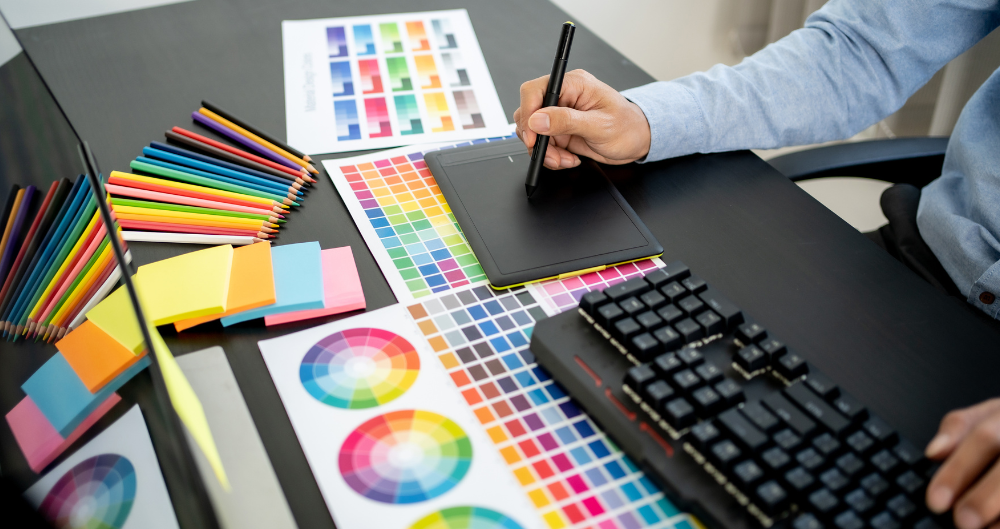How to Become a Digital Designer (2024)

Are you aspiring to become a digital designer? This will guide you with an easy-to-follow roadmap that outlines the essential steps to turn your creative passion into a successful career.
Summary
- Digital designers create and design digital content, including websites and mobile applications.
- Work in various settings such as digital agencies, in-house design teams, or as freelancers.
- Typically needs a relevant degree, technical and creative skills, and industry-recognized certifications.
6. Colorado
Building a network through industry events and maintaining a versatile portfolio is crucial for success in becoming a Digital designer in Colorado.
Hourly mean wage: $55.64
Employment: 2,720
7. Massachusetts
Pursuing advanced degrees in becoming a digital designer in Massachusetts can be beneficial. Particularly in the Boston area, they offer a strong market for digital designers.
Hourly mean wage: $54.64
Employment: 2,340
8. Georgia
To excel in Georgia, gaining hands-on experience in becoming a digital designer in Georgia and staying active in the design community are important steps.
Hourly mean wage: $52.43
Employment: 2,120
9. New Hampshire
Focusing on developing niche skills and connecting with local businesses can help you stand out as a Digital designer in New Hampshire.
Hourly mean wage: $54.69
Employment: 1,990
10. District of Columbia
To thrive in becoming a Digital Designer in the District of Columbia, honing skills and public sector design can be advantageous.
Hourly mean wage: $46.29
Employment: 1,220
Where can I find Digital Designer classes?
If you're interested in pursuing a career as a Digital Designer, you can find relevant classes on Dreambound. Dreambound is the largest platform for students to find and compare vocational training programs. They offer a comprehensive selection of Digital Designers classes to help you gain the necessary knowledge and skills. Its user-friendly interface and detailed course information make it easy to compare different options and choose the best fit for your needs.
How much does a Digital Designer make?
A digital designer's salary varies based on factors such as experience, location, and industry. On average, digital designers in the United States earn between $50,000 and $80,000 annually, with entry-level positions starting around $40,000 and experienced designers in high-demand areas or specialized fields making upwards of $100,000 per year. Freelance digital designers may have different earning potentials depending on their client base and project rates.
What’s Next After Becoming a Digital Designer?
As a digital designer, you can explore various career paths and opportunities, such as:
- User Experience (UX) Designer: Focus on designing intuitive and user-friendly digital experiences.
- Visual Designer: Specializes in creating visually appealing and aesthetically-driven digital content.
- Art Director: Lead a team of designers and oversee the creative direction of digital projects.
- Creative Director: Oversee the overall creative vision and strategy for a company or agency.
- Freelance or Entrepreneurial Opportunities: Start your own design studio or offer your services as a freelance digital designer.
Frequently Asked Questions
How long does it take to become a digital designer?
It typically takes 2-4 years to become a digital designer with a relevant degree. However, with self-study or online courses, you can start in a few months to a year.
Is it hard to be a digital designer?
Becoming a digital designer can be challenging, but it is also rewarding. The difficulty largely depends on your aptitude for creative thinking, problem-solving, and technical skills. It requires continuous learning to keep up with new tools, trends, and technologies. However, with dedication, practice, and the right resources, many find it to be a fulfilling career.
How to get started in digital design?
Start by learning the basics through online courses, familiarize yourself with design tools, build a portfolio, stay updated with industry trends, network with professionals, and consider formal education for structured learning.
Final Thoughts
Becoming a digital designer can be a rewarding and dynamic career path. With a passion for creativity and the right skills, you can carve out a fulfilling career in this vibrant field. By enrolling in a program that offers a solid foundation in graphic design or digital media, you'll gain the expertise needed to bring your ideas to life. Take the first step today and unlock your potential as a digital designer—where creativity meets innovation and every project becomes a canvas for your imagination to flourish.
If this article isn't quite hitting the mark for you, why not give these other articles a try:

Athena is Co-founder and CEO of Dreambound.



